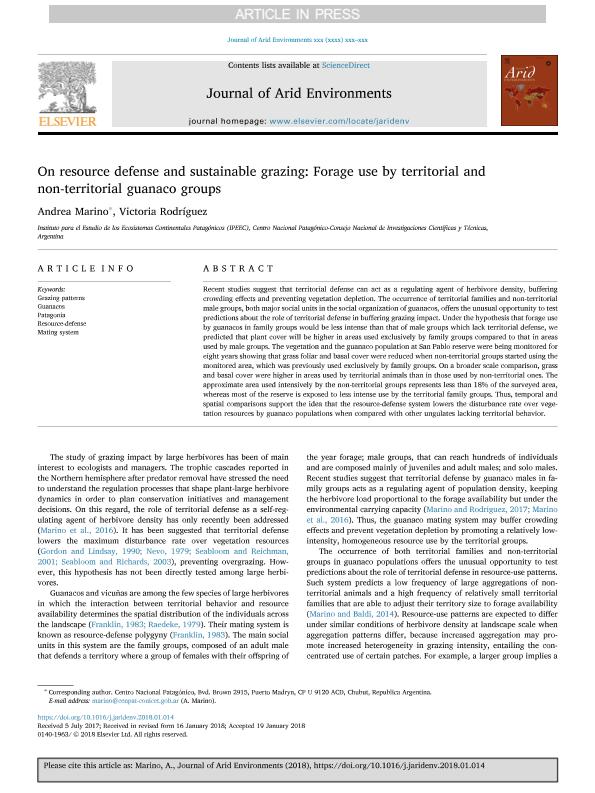Mostrar el registro sencillo del ítem
dc.contributor.author
Marino, Andrea Ivana

dc.contributor.author
Rodriguez, Maria Victoria

dc.date.available
2020-06-23T20:32:47Z
dc.date.issued
2018-05
dc.identifier.citation
Marino, Andrea Ivana; Rodriguez, Maria Victoria; On resource defense and sustainable grazing: Forage use by territorial and non-territorial guanaco groups; Elsevier; Journal of Arid Environments; 152; 5-2018; 87-90
dc.identifier.issn
0140-1963
dc.identifier.uri
http://hdl.handle.net/11336/108024
dc.description.abstract
Recent studies suggest that territorial defense can act as a regulating agent of herbivore density, buffering crowding effects and preventing vegetation depletion. The occurrence of territorial families and non-territorial male groups, both major social units in the social organization of guanacos, offers the unusual opportunity to test predictions about the role of territorial defense in buffering grazing impact. Under the hypothesis that forage use by guanacos in family groups would be less intense than that of male groups which lack territorial defense, we predicted that plant cover will be higher in areas used exclusively by family groups compared to that in areas used by male groups. The vegetation and the guanaco population at San Pablo reserve were being monitored for eight years showing that grass foliar and basal cover were reduced when non-territorial groups started using the monitored area, which was previously used exclusively by family groups. On a broader scale comparison, grass and basal cover were higher in areas used by territorial animals than in those used by non-territorial ones. The approximate area used intensively by the non-territorial groups represents less than 18% of the surveyed area, whereas most of the reserve is exposed to less intense use by the territorial family groups. Thus, temporal and spatial comparisons support the idea that the resource-defense system lowers the disturbance rate over vegetation resources by guanaco populations when compared with other ungulates lacking territorial behavior.
dc.format
application/pdf
dc.language.iso
eng
dc.publisher
Elsevier

dc.rights
info:eu-repo/semantics/openAccess
dc.rights.uri
https://creativecommons.org/licenses/by-nc-sa/2.5/ar/
dc.subject
GRAZING PATTERNS
dc.subject
GUANACOS
dc.subject
PATAGONIA
dc.subject
RESOURCE-DEFENSE
dc.subject
MATING SYSTEM
dc.subject.classification
Ecología

dc.subject.classification
Ciencias Biológicas

dc.subject.classification
CIENCIAS NATURALES Y EXACTAS

dc.title
On resource defense and sustainable grazing: Forage use by territorial and non-territorial guanaco groups
dc.type
info:eu-repo/semantics/article
dc.type
info:ar-repo/semantics/artículo
dc.type
info:eu-repo/semantics/publishedVersion
dc.date.updated
2020-06-19T18:19:27Z
dc.identifier.eissn
1095-922X
dc.journal.volume
152
dc.journal.pagination
87-90
dc.journal.pais
Países Bajos

dc.journal.ciudad
Amsterdam
dc.description.fil
Fil: Marino, Andrea Ivana. Consejo Nacional de Investigaciones Científicas y Técnicas. Centro Científico Tecnológico Conicet - Centro Nacional Patagónico. Instituto Patagónico para el Estudio de los Ecosistemas Continentales; Argentina
dc.description.fil
Fil: Rodriguez, Maria Victoria. Consejo Nacional de Investigaciones Científicas y Técnicas. Centro Científico Tecnológico Conicet - Centro Nacional Patagónico. Instituto Patagónico para el Estudio de los Ecosistemas Continentales; Argentina
dc.journal.title
Journal of Arid Environments

dc.relation.alternativeid
info:eu-repo/semantics/altIdentifier/doi/http://dx.doi.org/10.1016/j.jaridenv.2018.01.014
dc.relation.alternativeid
info:eu-repo/semantics/altIdentifier/url/https://www.sciencedirect.com/science/article/abs/pii/S0140196318300478
Archivos asociados
